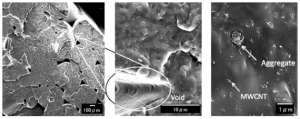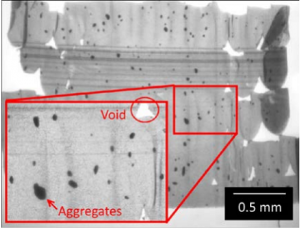Comparing FDM 3D Printed Parts with Carbon Nanotubes, Continuous Carbon Fiber and Short Carbon Fiber
Fused deposition modeling, or FDM, 3D printing has several advantages – thermoplastics can be used, which are easy to handle and are strong and durable enough to be used for producing both prototypes and practical parts. Additionally, FDM 3D printers use a simple mechanism to melt and extrude resin that doesn’t need expensive parts, like lasers, which makes the machines less expensive. But, the technology does not always provide enough strength for mechanical parts.
That’s why additional materials with good mechanical properties, such as carbon nanotubes (CNT) and fiber reinforced composites, are often added to improve strength; depending on the length, carbon fiber can also be divided up into both short and continuous fiber. A group of researchers from Doshisha University and Kyoraku Co., Ltd., both in Japan, recently published a study, titled “Comparison of strength of 3D printing objects using short fiber and continuous long fiber,” that compared the usefulness and strength of objects 3D printed with short carbon fiber, continuous carbon fiber, and multi-wall carbon nanotube (MWCNT).
The abstract reads, “In this research, composite materials were used to improve the strength of FDM 3D printed objects. The nanocomposites made from polylactic acid as matrix and multi-wall carbon nanotube as filler, short carbon fiber reinforced composite and continuous carbon fiber reinforced composite were prepared, and tensile test was carried out. As a result, the continuous fiber reinforced material exhibited tensile strength of about 7 times and elastic modulus about 5 times that of the other two materials. The strength was greatly improved by using the continuous fiber. The fracture surface after the test was observed using a scanning electron microscope. The result of observation shows that adhesion between the laminated layers and the relationship between the fiber and the matrix are bad, and improving these are necessary to increase strength. Comparing those materials, it is possible to improve the strength in some degree by using short fiber while maintaining ease of printing. On the other hand, by using continuous fiber it can be achieved significant strength improvement while printing was complicated.”
To make their PLA/MWCNT nanocomposite, the researchers used polylactic material as a matrix, with MWCNT as a filler, and formed the material into a 1.75 mm filament. They used commercial ONYX, carbon fiber, and NYLON materials from Markforged to 3D print tensile test pieces from continuous carbon fiber reinforced thermoplastic (continuous CFRTP) and short carbon fiber reinforced thermoplastic (short CFRTP).
“The specimen shape is different due to the limitation by the performance of the 3D printer,” the researchers wrote in the paper. “For PLA/MWCNT, smaller one was chosen to avoid warp and print quickly. The PLA/MWCNT has three outer walls and fills inside alternately at 45 degrees and -45 degrees.”
For the continuous CFRTP, carbon fibers oriented in the load direction were 3D printed in the center, while the outside was covered with either neat resin or short fiber reinforced composite; this last was used to 3D print the short CFRTP in the same manner as the PLA composite had been fabricate.
The researchers completed a tensile test on the pieces, and used a scanning electron microscope to observe images of the specimen’s fracture surface. They also looked at their stress and strain.
“In PLA/MWCNT, the stress increased almost linearly until fracture,” the paper explained. “The breaking strain was about 1 ~ 2%, and no stress reduction was occurred. Compared with neat PLA, the elastic modulus was not greatly improved but the tensile strength was improved and increased by 48% when 1wt% of MWCNT is added. In that case, the tensile strength was 53 MPa and the Young’s modulus was 3 GPa. Until 1 wt%, the tensile strength was improved as more CNT is added, but strength was decreased when 3wt% was added. It is because the aggregation of MWCNT. The aggregations are considered to act as internal defects of the material.”
When more MWCNT was added, the number of aggregates increased. The researchers found that the relationship between the fiber and the matrix, along with adhesion between the laminated layers, was not good – when these are improved, the strength will increase. Significant strength improvements can be achieved by using continuous fiber, but the 3D printing process is complicated, and it’s necessary to use modified equipment, such as a special nozzle. But short fiber is easier to print, and still offers some degree of improved strength.
“The short CFRTP and PLA/MWCNT are inferior in mechanical properties compared to the continuous. But they can be printed with conventional 3D printers without special modifying,” the researchers explained. “Especially the nanocomposites demonstrate its effect by adding a small amount. The mass concentration of fiber was 35.7 wt% for continuous CFRTP and 14.3 wt% for short CFRTP, but MWCNT was 3wt% or less. Generally, the smaller the amount of reinforcement, the more easy to print. In fact the PLA/MWCNT nanocomposite can be printed with commercially available 3D printer without special modified in this study. Continuous fiber and short fiber material should each have merits and demerits and should be used properly.”
Co-authors of the paper are T. Isobe, T. Tanaka, T. Nomura, and R. Yuasa.
Discuss this and other 3D printing topics at 3DPrintBoard.com or share your thoughts below.
Subscribe to Our Email Newsletter
Stay up-to-date on all the latest news from the 3D printing industry and receive information and offers from third party vendors.
You May Also Like
Nikon’s AM Expansion from California to Japan and Beyond: CEO Hamid Zarringhalam Weighs in
As we recently argued in a 3DPrint.com PRO article, Nikon Advanced Manufacturing has quickly gone from a prominent player in the metal additive manufacturing (AM) sector to become one of,...
The State of the Talent and Job Market in AM: 2025 Outlook
The additive manufacturing industry has seen significant shifts in recent years, with 2024 marking a critical turning point. Economic pressures, evolving hiring trends, and an increasing talent shortage at the...
SWISSto12 to 3D Print Antennas for SES’s Medium Earth Orbit Satellite Constellation
SWISSto12 has made a remarkable journey in satellite manufacturing. The company now produces its own HummingSat, as well as 3D-printed filters, waveguides, and other RF components. Recently, it was selected...
3DPOD 243: Volumetric 3D Printing with Xolo CCO, Stephan Kuehr
Stephan Kuehr began his career at 3YOURMIND before joining the volumetric 3D printing firm Xolo. In this episode of the 3DPOD, we discuss Xolo, its technology, volumetric 3D printing, bioprinting,...

































